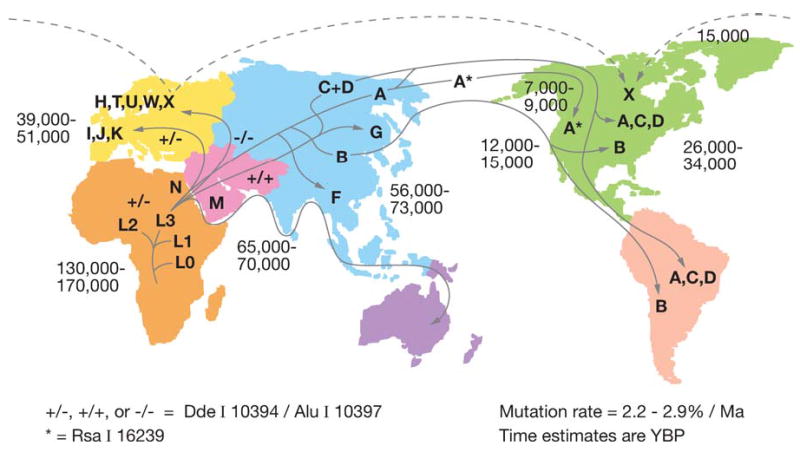Figure 5.

Diagram outlining the migratory history of the human mtDNA haplogroups. Homo sapiens mtDNAs arose in Africa about 150,000 to 200,000 years before present (YBP), with the first African-specific haplogroup branch being L0, followed by the appearance in Africa of lineages L1, L2, and L3. In northeastern Africa, L3 gave rise to two new lineages, M and N. Only M and N mtDNAs succeeded in leaving Africa and colonizing all of Eurasia about 65,000 YBP. In Europe, N gave rise to the H, I, J, Uk, T, U, V, W, and X haplogroups. In Asia, M and N gave rise to a diverse range of mtDNA lineages including A, B, and F from N and C, D, and G from M. A, C, and D became enriched in northeastern Siberia and crossed the Bering land bridge about 20,000 to 30,000 YBP to found the Paleo-Indians. At 15,000 YBP, haplogroup X came to central Canada either from across the frozen Atlantic or by an Asian route of which there are no clear remnants today. At 12,000 to 15,000 YBP, haplogroup B entered the Americas, bypassing Siberia and the arctic, likely by moving along the Beringian Coast. Next at 7000 to 9000 YBP, a migration bringing a modified haplogroup A moved from the northeastern Siberia into northwestern North America to found the Na-Dene (Athebaskins, Dogrib, Apaches, and Navajos). Finally, relatively recently, derivatives of A and D moved along the Arctic Circle to found the Eskimos. These observations revealed two major latitudinal discontinuities in mtDNA variation: one between the Africa L haplogroups and the Eurasia and N and M derivatives and the other between the plethora of Central Asian mtDNA lineages and the almost exclusive presence of lineages A, C, and D northeastern Siberia, the latter spawning the Native American migrations. Since these discontinuities correspond to the transitions from tropical and subtropical to temperate and from temperate to arctic, we have proposed that these discontinuities were the result of climatic selection of specific mtDNA mutations that permitted certain female lineages to prosper in the increasingly colder northern latitudes. Reprinted from http://www.mitomap.org.
